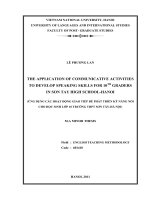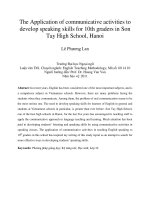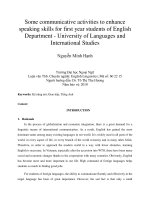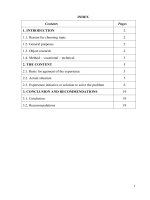- Trang chủ >>
- THPT Quốc Gia >>
- Ngoại Ngữ
Is Task-based Language Teaching or Communicative Language Teaching more effective in helping young learners to learn speaking skills?
Bạn đang xem bản rút gọn của tài liệu. Xem và tải ngay bản đầy đủ của tài liệu tại đây (249.22 KB, 15 trang )
<span class="text_page_counter">Trang 1</span><div class="page_container" data-page="1">
<b>TRA VINH UNIVERSITYSchool of Foreign Languages</b>
<b>English Teaching MethodologyTopic: Is Task-based Language Teaching or CommunicativeLanguage Teaching more effective in helping young learners to learn</b>
<b>speaking skills?</b>
<b>Instructor: PhD. Chau Thi Hoang HoaStudent: Nguyễn Hoài Nam</b>
<b>Student’s code: 910922015Class: CHTA- TV2208</b>
<b>Tra Vinh 2023</b>
</div><span class="text_page_counter">Trang 2</span><div class="page_container" data-page="2"><b>Is Task-based Language Teaching or Communicative LanguageTeaching more effective in helping young learners to learn speaking</b>
This assignment explores how effective CLT and TBLT are in the teaching of speakingskills in Vietnam respectively. This will enable teachers to implement the appropriatemethod enabling Vietnamese learners to improve and develop their communicativecompetence. This paper derives from an in-depth study to help to improve the learning andteaching activities in the future. It is theoretically evident here that both approaches can be usedto improve the communicative competence in the teaching of spoken English in the Vietnamesecontext. Considering all the points mentioned, this study aims to investigate if CLT or TBLT ismore effective in the teaching of speaking skills for young learners.
<b>Keys: Communicative language teaching, Speaking skill, Task-based language teaching</b>
English is one of the most common international languages in the world. LearningEnglish helps students form and develop their English communicative ability by practicinglistening, speaking, reading and writing skills. English learning is also a beginning step informing and developing long-life studying skills, working ability in the future and cultural-social activity participation at the same time. Besides, English study gives students a chanceto form their idea-expressing ability confidently, independently and creatively. In Viet Nam,English is a compulsory subject in the general education curriculum from grades 3 to 12(MOET). As one of the instrumental subjects in school, English not only enables students toformulate and develop their communicative competences in English but also contributes tothe formation and development of general competences to live and work more effectively,to learn other subjects well and for lifelong learning.
In terms of methodological innovation, the new English curriculum advocates “twopopular approaches in education and foreign language teaching internationally anddomestically: the learner-centered approach and the communicative approach in foreignlanguage teaching, in which Task-based language teaching is the principle method ofteaching”
(Decision N0 1400/QD – TTg by MOET 2008)
. Brown (2001:232), classified</div><span class="text_page_counter">Trang 3</span><div class="page_container" data-page="3">the skills at English namely listening, speaking, reading, and writing. Furthermore, hedivided listening and reading as receptive skills, otherwise speaking and writing asproductive skills. Speaking as a productive skill is an important aspect in language learning.By speaking, we can convey information and ideas, express opinion and feeling, shareexperiences, and maintain social relationships by communicating with others. In classroomsof today, we see more and more learners' responses taking place. As a result, the Englishsyllabus has also been revamped to produce youths which will be able to communicateproficiently in English and not merely in grammar theories. Communicative LanguageTeaching (CLT) and Task-based Language Teaching (TBLT) have been utilized to teachsecond and other foreign languages to learners in most nations, including Vietnam,throughout the last few decades. CLT aims to make communicative competence the goal oflanguage teaching and to develop techniques and procedures for teaching language skillsthat are based on the symbiotic relationship between language and communication. On theother hand, TBLT can be useful in the foreign language learning where students haveminimal or no exposure to the target language beyond the class (Jeon, 2006).
<b>1. Task-based language teaching (TBLT)1.1 Definitions</b>
Before revisiting definitions of TBLT, I would like to first discuss definitions of Tasks.Defining a task has been a subject of debate. A pioneering study on language tasks is fromPrabhu (1987, p. 24) who sees a task as "an activity which required learners to arrive at anoutcome from given information through some process of thought, and which allowedteachers to control and regulate that process". Willis (1996) also agrees that a task is anactivity in which the focus is to thrive learners’ interaction to reach the task outcome. Atask, in Nunan (1989, 2004) view “a communicative task is a piece of classroom workwhich involves learners in comprehending, manipulating, producing, or interacting in thetarget language while their attention is principally focused on meaning rather than form. Thetask should also have a sense of completeness, being able to stand alone as a communicativeact in its own right”. According to Lee (2000) a task is “ (1) a classroom activity or exercisethat has: (a) an objective obtainable only by interaction among participants, (b) amechanism for structuring and sequencing interaction, and (c) a focus on meaningexchange; (2) a language learning endeavor that requires learners to comprehend,
</div><span class="text_page_counter">Trang 4</span><div class="page_container" data-page="4">manipulate, and/or produce the target language as they perform some sets of work plans” [7,p.23].
Among the above definitions, the one given by Lee (2000) can be considered as easy tounderstand, complete and scientific as well as logical. Because it is present in almost all thatis mentioned by other authors.
In addition there are many different definitions and views about TBLT as well as aboutTask, TBLT refers to “an approach based on the use of tasks as the core unit of planning andinstruction in language teaching” (Richards & Rodgers, 2001, p. 223). Chen (2017)describes TBLT as a further development of communicative language teaching in whichstudents should construct their communicative competence through completing tasks givenby their teacher in various situations. Moreover I would like to introduce a definition that isconsidered to be the most convincing of TBLT by David Nunan (2001), and has beenrecognized by a researcher. Vietnamese studies by Le Van Canh reused in the bookpublished in 2004 (a) an emphasis on learning to communicate through interaction in thetarget language (b) the introduction of authentic texts into the learning situation (c) theprovision of opportunities for learners to focus, not only on language, but also on thelearning process itself (d) an enhancement of the learner's own personal experiences asimportant contributing elements to classroom learning (e) an attempt to link classroomlanguage learning with language activation outside the classroom.”
<b>1.2 Framework of TBLT</b>
The classroom instruction model of the TBLT teaching method proposed by Willis(1996) is the clearest model and the most widely agreed upon by scholars. This modelincludes three phases: Pre-task (before Task execution), Task Cycle (Task execution phase)and Language Focus (Post-Task phase and/or Language analysis phase). Thus, it can beseen that the classroom instruction model proposed by Willis has stated very specifically thetasks that teachers and learners have to perform at each stage. This model has the followingoutstanding advantages: (1) Very clear and specific than any classroom teaching model ofany other foreign language teaching method, (2) Easy to follow, (3) Very flexible becausethe small steps in the same phase can be swapped, done completely or omitted if not needed,(4) Learners feel interested because the Tasks are often related. related to the activities ofthe outside life, and because they are involved in solving problems of practical significance,(5) Highly scientific because learners not only use language to communicate but vice versa.
</div><span class="text_page_counter">Trang 5</span><div class="page_container" data-page="5">is to use communication itself to solve the task, (6) Learners not only improve their solving skills and communication fluency, but also pay attention to accuracy, (7) Learners'ability is steadily and surely improved because this model not only helps learners to learnaccording to the philosophy of "learning by doing" Vygotsky (1978) [13] and Bruner (1980)[1] was mentioned
<b>task-Figure 1.2: A framework of TBLT Willis (1996)</b>
<b>1.3 The strengths and weakness of TBLT</b>
Task based language learning offers a lot of advantages as it is communication basedand allows the learners to transfer previously acquired knowledge to new communicativecontexts (Nunan,1989).It encourages the learner to emerge as a language user. It intends toengage the language learner in a meaning focused language usage (Breen 1989 as cited inEllis, 2009). In addition TBLT is aimed at developing learners’ capacity to engage in significantand fluent communication (Bui, Thi Tuyet Ngan as cited Ellis, 2003; Willis & Willis, 2009).Students in college prefer to learn knowledge connected with their daily life rather than learn fixedor obsolete articles from a text book because they consider grammar to be no practical help to them.TBLT meets the need of learners by helping to engage with meaning in order to develop a languagesystem (Beglar & Hunt, 2002; Willis & Willis, 2009). According to Willis & Willis (2007), TBLTprovides many opportunities for learners to use the language that they know without beingpenalized for their inevitable failures in accuracy.
However not everyone accepts these strengths and it remains a controversial approach. Bruton(2002) agreed with Swan (2005) that TBLT is unsuitable for low-level learners. In the task-cyclephase, students are required to communicate with their classmates and weak learners often lackproficiency to communicate in the target language to fulfill the assigned task. According toTavakoli (2009) the difficulty of a task can be estimated from the performance of learners, the
</div><span class="text_page_counter">Trang 6</span><div class="page_container" data-page="6">factors that actually contribute to task difficulty are studied so that it is useful to integrate andsequence the tasks in language teaching syllabus. Studies indicate that the same classroom event isoften interpreted differently by the teachers and learners (Kumaravadivelu, 2003 )
Seedhouse (1999) stated that it results in impoverished language use that is of little acquisitivevalue. Students may resort to communicating in their native language instead. In addition, the largesize of English classes is a problem for TBLT. Students hardly get a chance to speak if the group islarge because tasks are usually time-limited.
Last but not least, the assessment of task-based learning can be challenging. The nature ofTBLT prevents it from being quantifiable by the more controlled and conventional tests.
<b>1.4 TBLT in the teaching of speaking</b>
The theory of teaching speaking is sometimes neglected. The teaching approach used isstill ignored, though how best to approach the teaching of oral skills has long been thefocus of methodological debate. In fact, many students learn speaking for quite a long time,but they still cannot be able to practice speaking in the process of speaking improvement.This condition gives more intention about how teaching speaking methodology will affectthe teaching and learning speaking in the class.
Speaking learning materials also play an important role to help students succeed inlearning speaking. Materials created in the class must concern the students’ need to learn.
Material development should not become the obstacle to teach the students as there area lot of ways used to design it. Developing students' learning materials becomes theprocedure of preparing teachers to teach in the classroom. One of the learning approachesproposed to help teachers design materials is Task-Based Language Teaching (TBLT). Itsuits the current issues of teaching and learning methodology of the day. The teachers arefocusing on procedure or the series of pedagogical tasks to perform for students to speak.Based on the research done by the writer using TBLT, it shows that the use of TBLT iseffective in teaching speaking. (Musliadi, 2016)
<b>2. Communicative Language Teaching (CLT)2.1 Definitions</b>
Communicative Language Teaching (CLT) is a method of teaching second and foreignlanguage. This method highlights 'interaction' as both the technique and objective for
</div><span class="text_page_counter">Trang 7</span><div class="page_container" data-page="7">learning a language. In addition, it is known as the communicative approach to teachingforeign language or simply put, the communicative approach. CLT was said to haveoriginated from Britian during the 1960s. Hadley (2001.116) has shown that CLT is theresult of British research, adopted by linguists, typically Willkis, Widdowson, Candlin,Christopher Brumfit, Keith Johnson and many other American educators like Sauvignon…
Many linguists have given different definitions, Richard & Rorger (1986: 66) “CLT isan approach that aims to make communicative competence the goal of language teaching offour language skills that acknowledge the interdependence of language and communication”, Wikipedia (2008) Communicative language teaching (CLT) is an approach to the teachingof second and foreign language that emphasizes interaction as both the means and theultimate goal of learning a language. It is also referred to as “communicative approach tothe teaching of foreign language” or simply the “Communicative Approach”
<b>2.2 Framework of CLT</b>
In the Communicative Approach, language is viewed as a means of communication(Richards & Rodgers, 2014). Hence, the goal of language teaching is to achievecommunicative competence. Communicative competence refers to the knowledge and skillsof individuals to use the language for diverse purposes and functions (Richards & Rodgers,2014) which requires know-how in four areas: “grammatical competence”, “sociolinguisticcompetence”, “discourse competence”, and “strategic competence” (Canale & Swain, 1980,p. 4). In CLT, as the view of language and the goal of teaching reveal, communication is thebasic feature of the instructional process. Hence, the effectiveness of the classroomactivities, the teacher’s and learners’ roles, and student-teacher interaction are assessedaccording to how much they promote communication. Larsen-Freeman and Anderson(2011), for example, described the roles of the teacher in the CLT classroom as facilitatingcommunication while the learners are communicators.
</div><span class="text_page_counter">Trang 8</span><div class="page_container" data-page="8"><b>Figure 2.2: Canale and Swine’s Model of Communicative Competence (CC)</b>
<b>2.3 The strengths and weakness of CLT</b>
A variety of communicative activities i.e. role-play, interviews, information gap, games,conversation, questionnaires, group work, etc are integrated in CLT classroom (Larsen-Freeman, 1986). Belchamber (2007) also stated that if there is an atmosphere of trust andsupport in the classroom, students were more likely to contribute. One way of encouragingthis is to allow peer checking of answers before open-class checking occurs while another isto include an avenue for students to discuss a task in small groups. In addition stressed thatone of the main advantage of CLT is that the teacher can incorporate all four the language skills intothe lesson, and even into one lesson. The CLT approach enables the teacher to assume the role of“facilitator”. The teacher is able to observe the students through various activities and subsequentlyand respond to the students.( Bui, Thi Tuyet Ngan as cited, Geyser, 2008)
The CLT method can be tailored to any level from Pre-Beginner to Advanced and isapplicable for classes with students from different linguistic backgrounds and communicativecompetence; this allows the learners to intermingle with each according to their level of proficiency.By applying CLT in the classroom, the students will feel more involved in the learning process.
However, David Nunan (2004) stated that in reality CLT is not a teaching method, but rathera mixture of diverse approaches. Harmer (2009) stated the CLT approach has been criticized forbeing prejudiced in favor of the native language teachers as the activities create an unrestrictedrange of language forms by learners making it difficult for non-native teachers to respond to themultitude of language problems which may arise. This made it very difficult for teachers who arenot very proficient in the second language to teach effectively. Moreover, The CLT is not designedfor students coming from cultures with conventional educational systems. Vietnamese learners, forexample, come from a conventional educational background where they were (and till today) taught
</div><span class="text_page_counter">Trang 9</span><div class="page_container" data-page="9">using grammar-translation methods. These students are used to a strict teacher-centered and formalenvironment.
Last but not least, CLT focuses on fluency but not accuracy. During communicativeactivities, students are left on their own to solve their communication problems and they tend toform incoherent and grammatical incorrect sentences.
<b>2.4 CLT in the teaching of speaking</b>
In an EFL context, mastery of speaking is greatly dependent on the approaches toteaching speaking as the classroom is the decisive place where students learn and practicethe language. Predominantly, the approaches to teaching speaking are categorized into twomain types: direct approach and indirect approach. The direct approach, also known as acontrolled approach, to teaching speaking, focuses on the practice and development ofisolated language forms (Goh & Burns, 2012). According to Novakova (2016) claimed thatstructural accuracy and the use of language forms are the concern of the direct approach. Anindirect approach to teaching speaking, on the other hand, focuses on the creation ofconditions for oral interaction to enable learners to engage in communicative activities (Goh
<b>& Burns, 2012; Richards, 2008). </b>
<b>3. Background CLT and BTLT</b>
<b>3.1 Similarities between CLT and TBLT</b>
CLT is an approach to the teaching of foreign languages by emphasizing the use ofcommunication or interaction as the means and the eventual goal of learning a particular language.It is also often recognized as “a communicative approach to the teaching of foreign languages” or“the communicative approach”. TBLT on the other hand does not have a clear definition, but someproponents present it as the logical development of CLT because of the fact that its basic principleswere derived from the CLT movement of the 1980s (Littlewood, 2007). Moreover, Task-basedLanguage Teaching is believed to have originated from CLT (Kumaravadivelu, 2006; Nuna, 2004;Richards & Rodgers, 2001). TBLT is based upon several key CLT principles. For example, statesCLT represents a “broad philosophical approach to language curriculum developed upon thetheories and research in linguistics, anthropology, psychology, and sociology” while “TBLTrepresents an application of this philosophy at the levels of curriculum design and methodology”(Nunan,2004 p.10). Understanding CLT, therefore, may be regarded as a necessary move tounderstanding TBLT.
<b>3.2 Differences between CLT and TBLT</b>
</div><span class="text_page_counter">Trang 10</span><div class="page_container" data-page="10">However CLT and TBLT are differences. Tuyet Ngan Bui then cites other study: Theintroduction of CLT in foreign language acquisition in the early 1980s resulted in strong emphasisbeing placed upon the learners’ communicative ability. TBLT has also drawn the attention of manyresearchers as a result of its process-based syllabus which is aimed at increasing learners’ actuallanguage use for communicative purposes. TBLT applies a learner-centered approach (Ellis, 2003;Nunan, 2004; Richards & Rodgers, 2001); which includes certain key characteristics such as goal,procedure, and specific result (Murphy, 2003; Nunan, 2004; Skehan, 2003); it emphasizes content-based and meaning-based tasks as an alternative to linguistic forms (Carless, 2002; Littlewood,2007). There are also some distinct differences between the two methods with regards to theteacher-student roles
<b>Application in the teaching of speaking in EFL context</b>
English has been taught and learned in Vietnam as a foreign language for decades. Asreported in Canh & Barnard (2009: 23), the newly documented English language curriculumin Vietnamese high schools (Ministry of Education and Training [MOET], 2006) aims toeventually equip students with basic communicative competence in all four skills, as well asa formal knowledge of English and an appreciation of the cultures of English-speakingcountries. We can clearly see that the Vietnamese Education curriculum is also starting toplay catch-up with its peers in the region.
TBLT and CLT provide a new style for teaching and learning listening and speaking.The last phase is language focus, allowing us a closer study of some of the specific featuresthat naturally occur as a result of the language used during the task-cycle (Willis, 1996,pp.40). Some listening and speaking knowledge would be embedded in the tasks, and wouldmotivate learners to study in the 'language focus' section. For instance, teachers would askus to think about how 'would' is used and the effect of this high frequency word. We mightwork alone or in pairs before focusing on sentences and phrases to show the differentmeanings and uses.
This study focused on answering whether CLT or TBLT was more effective in theteaching of speaking in Vietnam, especially on students’ performance and their speakingresults. Through observations in classroom it was seen that student centered environmentwas attempted to assure in classes through talking about their favorite activity. Aboutcreating a collaborative learning environment, students in TBLT class were collaborative tocomplete all task-based activities. Through task-based activities, students could improve
</div>








